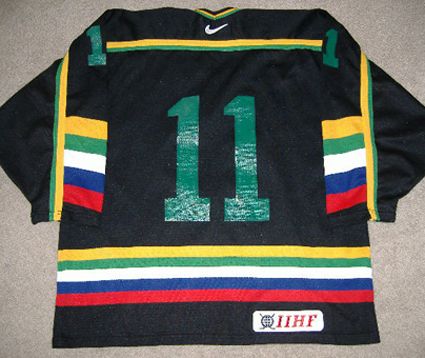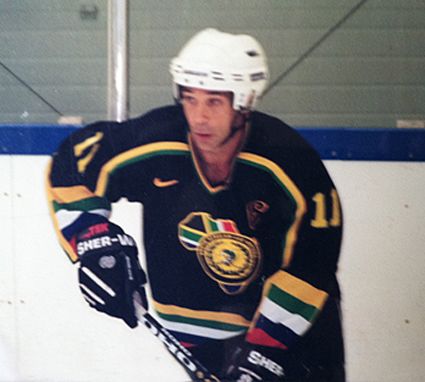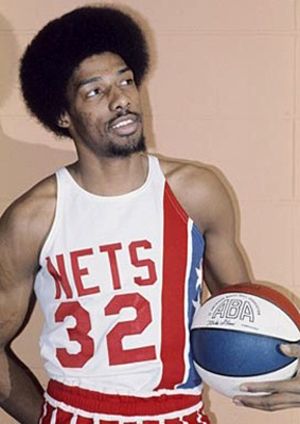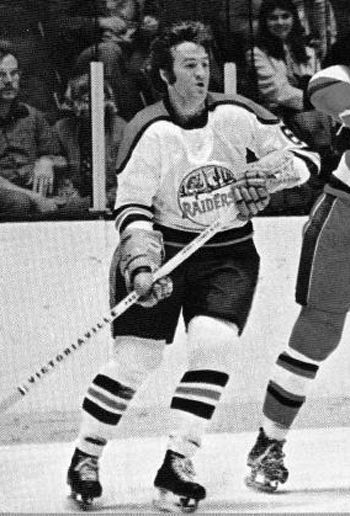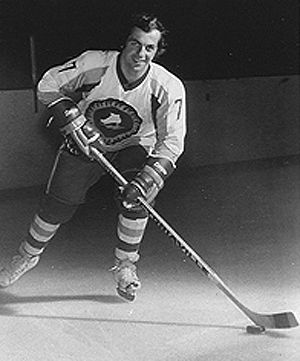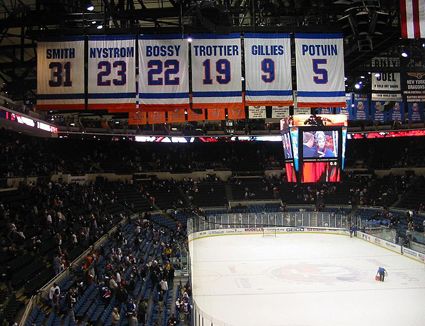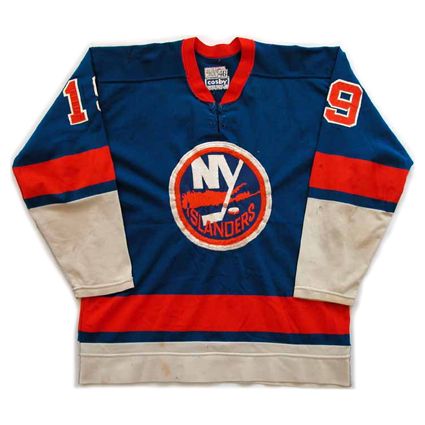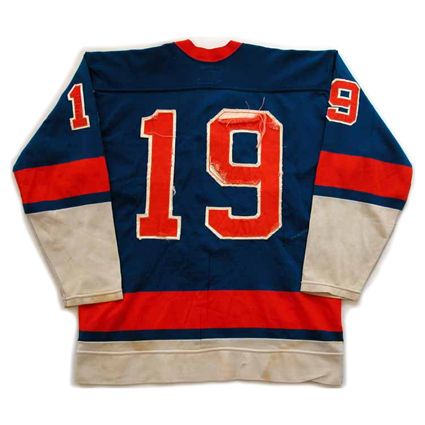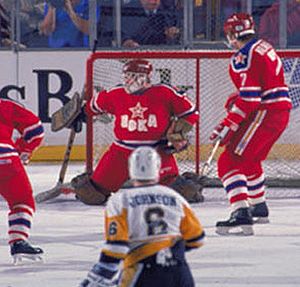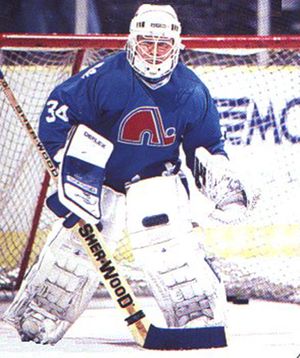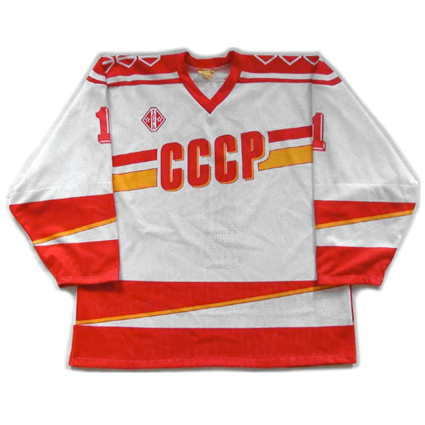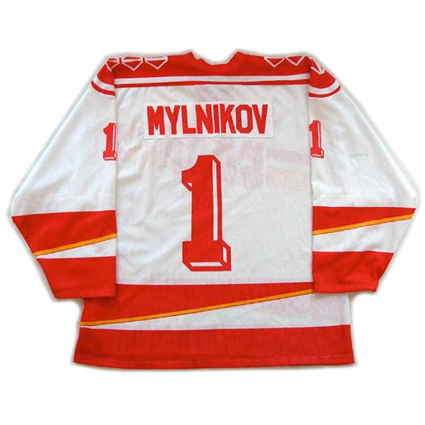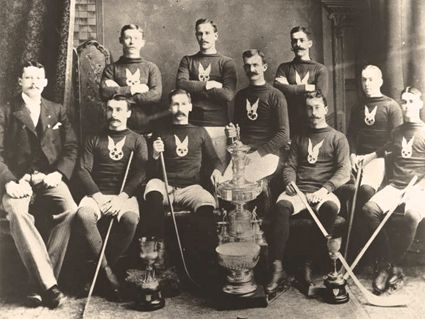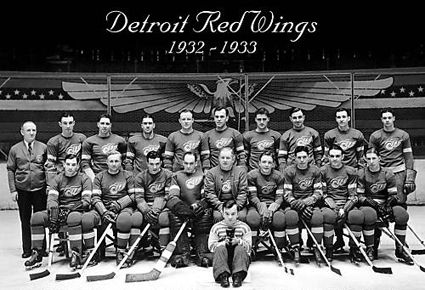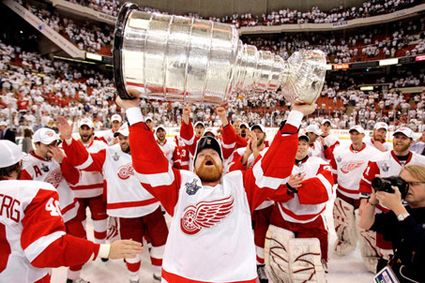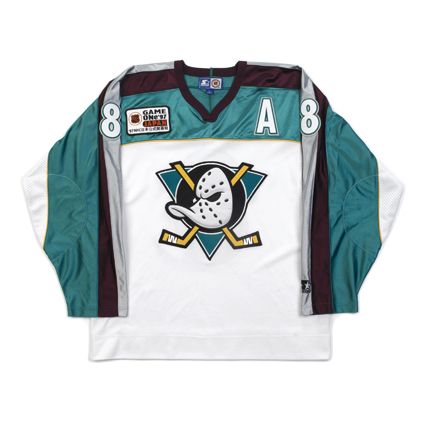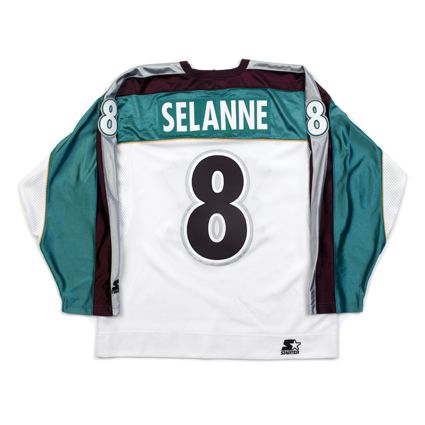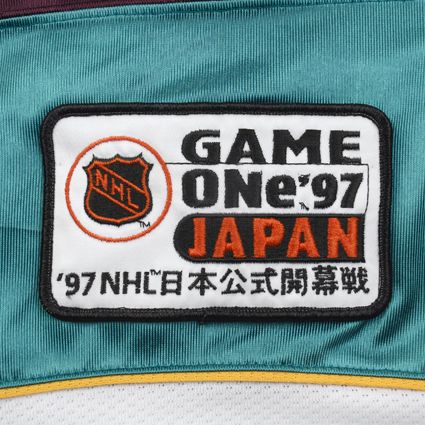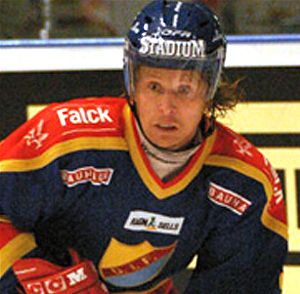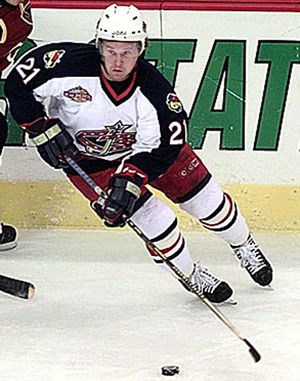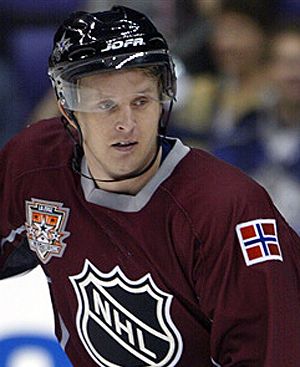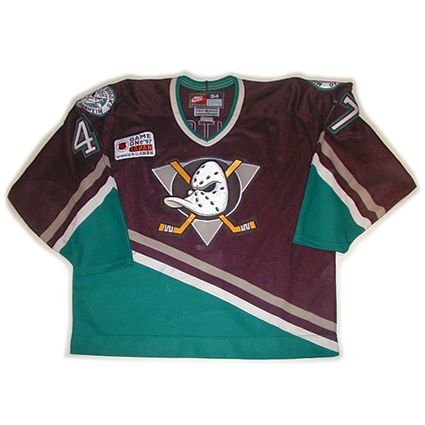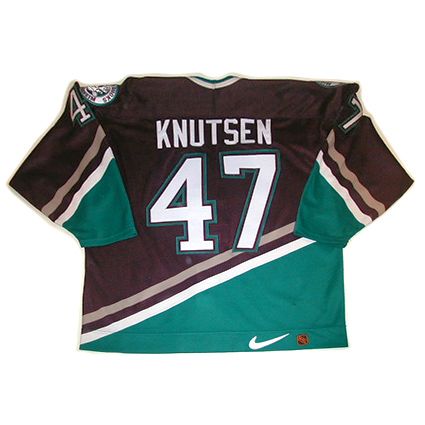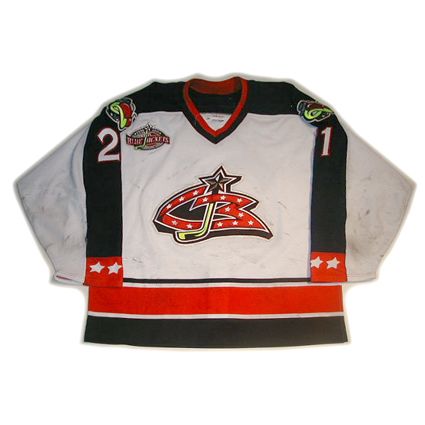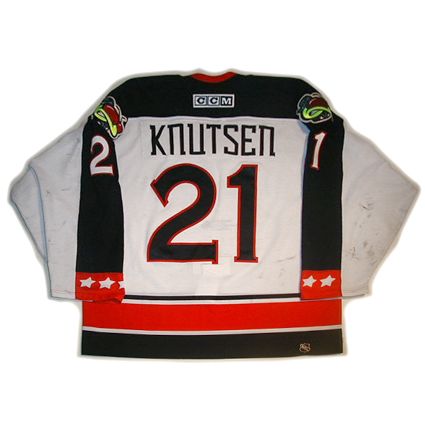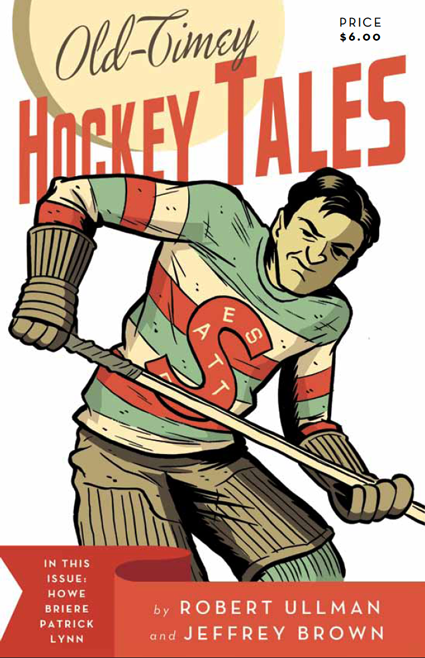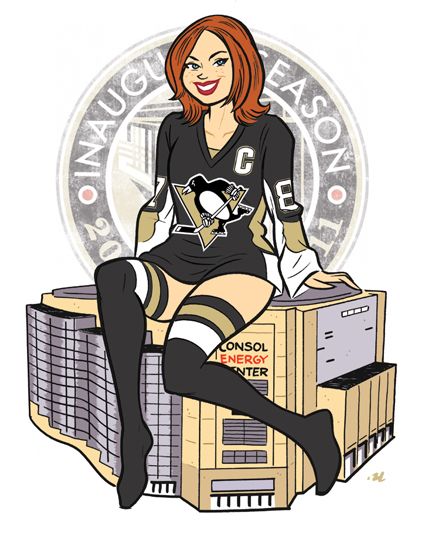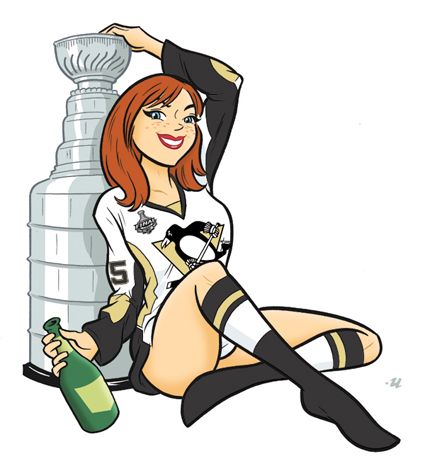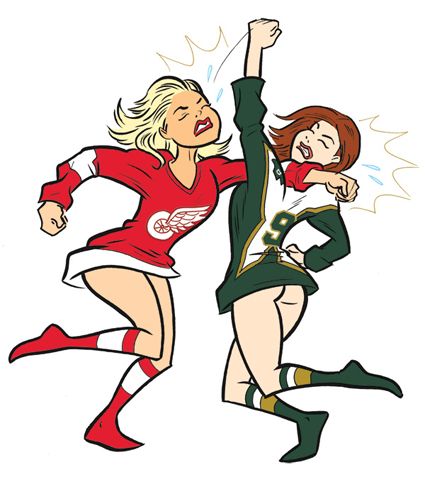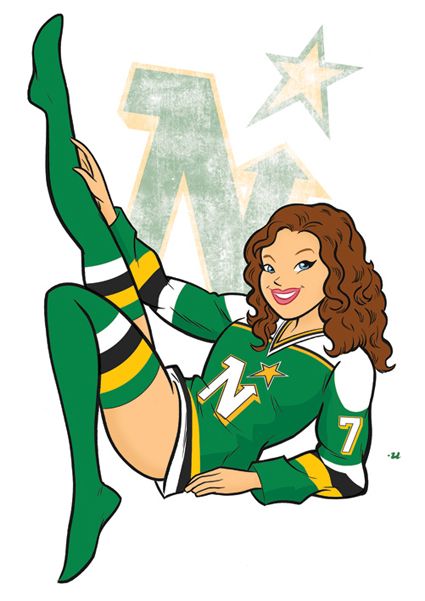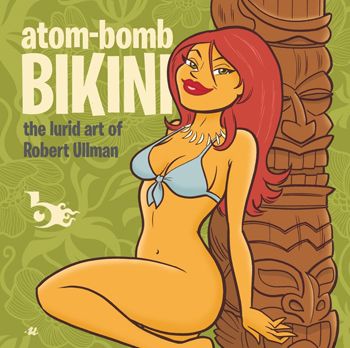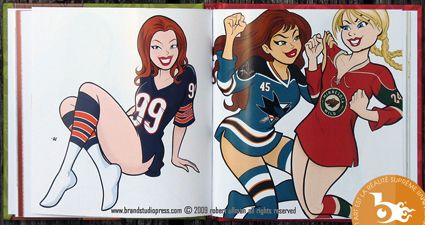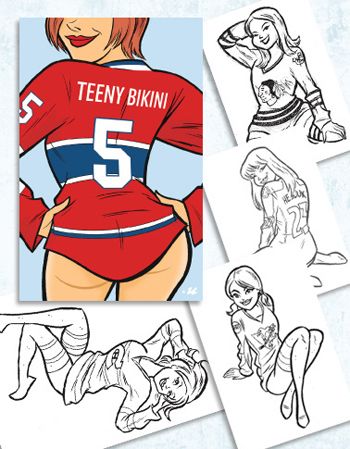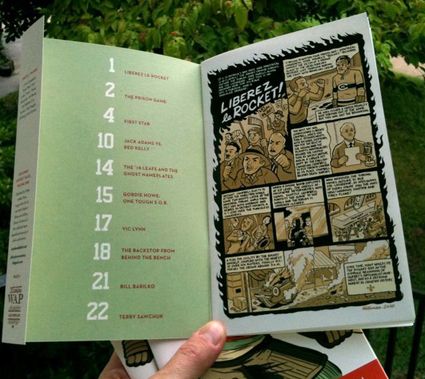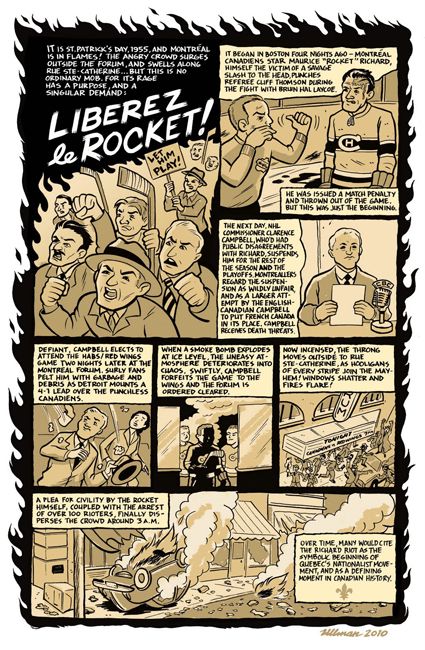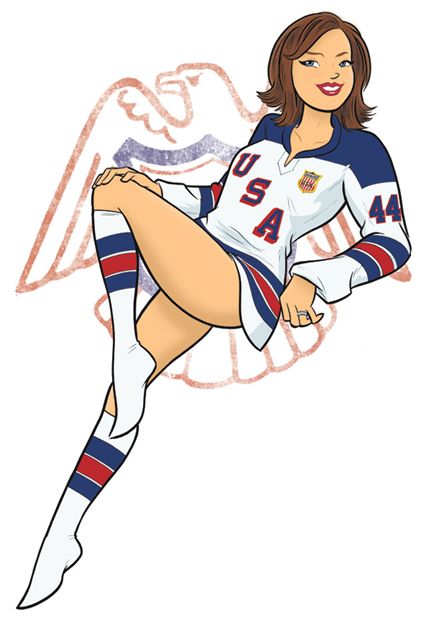This South Africa National Team jersey was worn in I THINK the 2000 IIHF Worlds (Pool D) by Alan Verwey. I actually traded for this jersey by sending some Roberto Luongo styled and colored Reebok goalie pads in exchange for a few jerseys. Alan gave the pads to his kids as a birthday gift. Later on I sent the matching blocker and glove in exchange for a few more. Along with this jersey I also received a game photo (which is VERY RARE to find for ANY level of the IIHF even 5 years ago).What I really love about this jersey is the colors. Every bit of the flag is incorporated. It's one fo the most unique and in my opinion best looking national team jerseys of all time. I will forever hold onto this jersey as it's really one of a kind.
Saturday, October 8, 2011
Reader Submission - 2000 South Africa National Team Alan Verwey Jersey
Out latest reader submission comes from international jersey collector and expert Anthony Ferra, who we know from being a fellow board member at the IceJerseys.com forums. He's also personally responsible for several gems in the Third String Goalie collection, as his pursuits of rare and obscure jerseys has led to him having numerous contacts around the globe which sometimes make available to him some really hard to find and wonderful jerseys which don't fit his personal collection, but are too hard to find to pass up.
His original desire was to obtain some Italy jerseys due to his Italian heritage, but things eventually progressed to the point where his goal now is to collect not just a jersey, but a Nike or SP brand game worn or team issued jersey from every member nation of the IIHF from 1996-2002 era, and we're not talking easy ones like Canada and the United States, who regularly market their own, but countries who inhabit the lower divisions such as Ireland, New Zealand, Israel, Greece and Mongolia, who you wouldn't even expect to have a national hockey program!
With none of these jerseys from the lower division teams having been made specifically for retail sale, the only ones available had to have been made for the teams, and this limited supply only increases the challenge to find them enormously.
This already difficult quest certainly cannot be made any easier by Anthony being based in Arizona! But, thanks to internet forums and social media like facebook, he's been able to make contacts with not only collectors, but actual team players and staff of the lower ranked national teams in order to pursue his quest, which bring us to today's jersey.
Truly a rare and unique jersey and if Anthony is impressed with how rare it is, trust us, it's rare. To see more of his collection, please click here to see jerseys from countries such as Australia, Belgium, Bulgaria, China, Croatia, Estonia, England, Greece, Hong Kong, Hungary, Iceland, Ireland, Greece, Korea, Lithuania, Mexico, Mongolia, the Netherlands, New Zealand, Romania, Spain, Taiwan, Thailand, Turkey and Yugoslavia, which isn't even a country anymore!
His "Holy Grail" (or is it his "White Whale"?) remains the elusive North Korea Nike jersey. While he has obtained a couple of more recent vintage post-2002 North Korean jerseys from Tackla, the older Nike era style remains elusive no doubt due to the scarcity of the jerseys, the language barrier between him and any players who may have one, and the isolationist policies of the North Korean government, which limit it's few hockey playing citizens from having access to the internet in order to even give Anthony a chance to even contact them.
If you are curious about what he has available for sale, check out his ebay listings under his user ID canucks109610 often to see what unusual jerseys he is able to acquire, but don't fit his personal collection.
To contact Anthony to talk about international jerseys or ask any questions, he can be reached at iihfjerseycollector@gmail.com. He can find you jerseys from almost any country you may be looking for and loves to talk jerseys.
Labels:
Reader Submissions,
South Africa
Friday, October 7, 2011
1972-73 New York Islanders Craig Cameron Jersey
Born as a result of a hasty effort by the National Hockey League to prevent the rival upstart World Hockey Association from placing a team at the Nassau Veterans Memorial Coliseum, the New York Islanders played their first game on this date in 1972.
The Nassau Coliseum
Located less than 20 miles from New York City on Long Island, the Coliseum originally held roughly 13,000 for hockey and slightly more for basketball, as the arena was also home to the New York Nets of the American Basketball Association from 1972 until 1977, who brought two ABA championships to New York behind the play of "Dr. J" Julius Irving.
Dr. J, Julius Irving
Some of the other teams to have called the Coliseum home have been the New York Arrows of the Major Indoor Soccer League (1978-1984), the New York Express, also of the MISL (1986-1987), the New York Saints of the National Lacrosse League (1989-2003) and the New York Dragons of the Arena Football League (2001-2008).
The Coliseum saw it's seating capacity expanded in the early 1980's to 16,250 for hockey and up to 18,100 for concerts. The arena has also hosted some of the World Wrestling Federation's biggest events as well as boxing and NCAA basketball regional round games.
In addition, some notable concerts have also been held there, including David Bowie, Queen, Bruce Springsteen, Billy Joel and was one of only two venues in the United States to host Pink Floyd's live show of "The Wall".
The motivation to quickly create the Islanders came about due to the new WHA planning on placing it's flagship franchise, the New York Raiders, in the brand-new Coliseum, a plan which was met with rejection by Nassau County officials, who wanted nothing to do with the new league which they did not consider to be major league. With the only way to legally keep the WHA out of the Coliseum being to place an NHL team there, and despite the fact the New York Rangers did not think highly of a competing team just 19 miles down the road, a hastily awarded team was given to Long Island in November of 1971, along with a second new club, the Atlanta Flames, to keep the league balanced.
While the plan cost the Islanders a $4 million territorial rights fee paid to the Rangers, it cost the Raiders even more, as they were forced to play in Madison Square Garden as tenants of the Rangers! Needless to say, the Rangers were less fans of the Raiders, who belonged to the rival WHA, than they were of the Islanders, who at least were members of the same NHL.
The WHA's New York Raiders
The unfavorable terms of the Raiders lease was a burden on the club, and when very few fans showed up to buy tickets, the original owners defaulted before the first season was even complete. WIth the league now owning the club, it was then sold to a new owner for the second WHA season and renamed the Golden Blades.
Andre Lacroix of the short-lived New York Golden Blades
The Golden Blades saw as few as 500 people show up, and 20 games into year two, the franchise once more became property of the league, who moved them to Cherry Hill, New Jersey, a suburb of Philadelphia for the remainder of the 1973-74 season where they had to play in a tiny arena (capacity 4,416) so awful it has achieved legendary status as the visiting teams not only had to put on their gear back at their hotel, but also skate uphill for two out of three periods thanks to a slope in the ice surface! Following the conclusion of the season, the franchise was moved to San Diego, California, seemingly as far from New York as possible! The formation of the Islanders had ultimately had the desired effect the NHL had hoped for.
The Islanders started slowly, preferring to build their club through the draft and passed on the temptation to sign veteran players, especially in light of the rapidly increasing size of player contracts due to competition from the WHA. The first year Islanders were led in scoring by Billy Harris, who managed 28 goals and 50 points in 78 games. For comparison, Phil Esposito led the league with 55 goals and 130 points.
The Islanders lost their first game at home 2-3 to the Flames on this date in 1972, but won their second game 3-2 over the Los Angeles Kings to earn their first victory in front of their home fans in their new arena.
It was not something the fans should have gotten used to however, as the Islanders dropped their next four games at home before a tie with the Chicago Black Hawks ended their inaugural homestand with a 1-5-1 record. For the remainder of the season, they would win 9 more games at home and only 2 on the road. Losing streaks of 12, 8, 7 games, as well as another winless streak of 12 doomed the Islanders to a distant last place with a 12-60-6 record for just 30 points, 18 back of the California Golden Seals and 35 back of fellow first year club the Flames!
However, their roster included not only Harris, but center Lorne Henning (63 games), wingers Bob Nystrom (11 games) and Gary Howatt (8 games) plus goaltender Billy Smith (37 games) who would remain with the team and achieve the heights of hoisting the first of four consecutive Stanley Cups just seven years later.
The Islanders hoist the first of four consecutive Stanley Cups
Bill Torrey, general manager of the Islanders tells his version of the competition with the Raiders and the rise of the Islanders. "The WHA originally wanted to get into the Nassau Coliseum but once the NHL made the commitment to put the Islanders there, I sensed we were in a situation that my club would be a target for the new league. The WHA put a team in New York at Madison Square Garden. THe Raiders wanted to weaken us as best as they could. I let them do it in a way. There were six or seven players that signed with the WHA that I had offered two-way, short-term contracts. I had a hunch they wouldn't accept my offer, but that was okay because I felt by building with younger players that we would draft, the Islanders would develop quicker and be better off in the long run.
At the time, the NHL was a two-division league. There really wasn't much chance for us to finish anywhere but where we finished, be it with a handful of wins and points. That wasn't important at the time. The WHA signed three or four players who I didn't care about and a couple of others who would have helped our organization. Still, we established a policy where our drafts, in '72, '73 and '74, would be all great ones. WE had a chance to let our future players mature faster. In the short term, it was tough. But in the big picture, things worked out well for us."
Their last place finish in 1972-73 allowed them to select franchise cornerstone Denis Potvin with the first overall pick in the 1974 NHL Draft. The following year the Islanders picked Clark Gilles fourth overall and Bryan Trottier in round two and the Islanders had the foundation for their dynasty of the early 1980's.
Time has passed the Coliseum by however, as it is now the second oldest building in the NHL with the lowest capacity (not to mention the lowest average attendance) and is viewed as an unsuitable building in the modern NHL, mainly due to it's lack of private suites and other modern features which provide essential money making opportunities for the club. Despite repeated attempts to replace it, none have come to fruition and the club is in real danger of having to relocate in the coming years.
Today's featured jersey is a 1972-73 New York Islanders Craig Cameron jersey. The first season of play for the Islanders saw them wear what would become the jersey the club would return to over and over again, despite a number of attempts to change to something different.
The orange numbers were unique to the first year Islanders jerseys, as they would be changed to white for the 1973-74 season and remain so on their dark jerseys ever since. The white sleeve ends and lace up collar would remain for the first five seasons before both disappeared in 1977-78, the same season names arrived on the back for good.
Our video section today takes a look at the history of the New York Islanders.
Thursday, October 6, 2011
1989 Soviet Union National Team Sergei Mylnikov Jersey
Born on this date in 1958 in the Soviet Union, Sergei Mylnikov began his professional career with Traktor Chelyabinsk in the Soviet League but first gained recognition by winning consecutive gold medals at the 1977 and 1978 World Junior Tournament. He would play three additional seasons with Traktor before he tended the nets for SKA Leningrad in both 1980-81 and 1981-82 but returned to Chelyabinsk the following year.
During his second stint with Traktor, Mylnikov made his World Championship debut in 1985 winning bronze medal, competed in the Izvestia Cup tournament and then a second World Championships in 1986 where he earned a gold medal.
1987 proved to be a busy year for Mylnikov, as he was a member of the Soviet National Team for Rendez-Vouz '87 against the NHL All-Stars and the 1987 World Championships (silver) before becoming the starting goaltender at the 1987 Canada Cup later that year where he led the Soviets to the finals against Canada which included the epic three game final, all with 6-5 scores, including two overtime games and the winner coming with less than a minute and a half remaining in Game 3.
After participating in the Soviet League for Chelyabinsk, he made his next international appearance at the 1988 Olympic Games as the Soviets number one goaltender, going 7-1 on the way to backstopping the Soviets to their final Olympic gold medal.
For the 1988-89 season, Mylnikov played for Traktor for the seventh consecutive season, was added to the roster of the Soviet Red Army club for their tour of North America and concluded his season with his fourth World Championships and another gold medal following a perfect 7-0 record.
Later that year, thanks to the change in the political situation in the Soviet Union, Mylnikov was drafted in the 7th round of the NHL Draft by the Quebec Nordiques. He found the transition to North America to be a difficult one, and it reflected in his performance, as in 10 games he posted a regrettable 1-7-2 record in what amounted to a lost season.
He rejoined the national team for the World Championships, where he regained his form with a 4-1 record and a 1.71 goals against average which earned him his third World Championships gold medal in his final international appearance.
He would rejoin Traktor for the 1990-91 season before joining Torpedo Yaroslavl for the 1991-92 and 1992-93 seasons. His playing days would conclude with two seasons with Säters IF in the Swedish third division before his retirement.
Mylnikov was inducted into the Russian and Soviet Hockey Hall of Fame in 1985.
Today's featured jersey is a 1989 Soviet National Team Sergei Mylnikov jersey as worn during the World Championships where Mylnikov was a perfect 7-0 on his way to the second of his three World Championship gold medals.
After wearing the spartan red and white style at the 1988 Olympics with CCCP straight across the chest and contained within a pair of horizontal lines, this new, modern style was introduced with the lettering as well as sleeve and waist stripes not only going up with a diagonal slant, but for the first time the addition of a third color, yellow.
This would be the final jersey worn by the Soviet Union, which included the infamous occasion where the Soviet World Junior team would start the 1992 World Junior Tournament only to have their country cease to exist while they were away winning gold!
This same style was worn at the 1992 Olympics in Lillehammer, Norway, only with the "CCCP" lettering removed, but the chest stripes still perfectly outlining the absent lettering.
Today's video section contains action from the Soviet Union against the United States from the 1988 Olympics in Calgary with Mylnikov in goal for the Soviets and a nice goal by Slava Fetisov.
This next clip is from the 1987 Canada Cup, where Mylnikov was in goal for the Soviets during the epic Game 3 of the finals, a dramatic 6-5 win for the Canadians on home ice.
Labels:
Mylnikov Sergei,
Soviet Union
Wednesday, October 5, 2011
1932-33 Detroit Red Wings John Roach Jersey
When the Western Hockey League ceased operations following the 1926 Stanley Cup finals, the new Detroit franchise in the then nine-year-old National Hockey League purchased the players of the Victoria Cougars.
In recognition of the source of their players, the expansion franchise was christened the Detroit Cougars. They actually played their first season across the river in Windsor, Ontario before moving into the newly completed Detroit Olympia, which would remain their home for over 50 years.
After four seasons as the Cougars, the club was renamed the Detroit Falcons for the 1930-31 season, but after just one more season as the Falcons, the team was sold to James Norris, who renamed his new purchase the Detroit Red Wings, which resulted a new set of sweaters with a new logo, which debuted on this date in 1932.
The new logo for the club, a winged wheel, originated from Norris' days as a player himself with the Montreal Hockey Club, which was affiliated with the Montreal Amateur Athletic Association and commonly referred to as "Montreal AAA", whose logo was was a winged wheel and were the first ever club to hold the newly donated Stanley Cup.
The 1893 Montreal AAA, the first Stanley Cup champions
The Red Wings newly designed sweaters were red with a white band at the bottom and a simple white stripe around each arm and was adorned with a new version of the winged wheel, only in a modernized version with a spoked automobile wheel and tire with the wings now going to the right rather than vertically. The numbers on the back were two colors at first, red outlined in white. As was the norm in that era, each team in the league had but one sweater, save the Toronto Maple Leafs who employed a white alternate which was worn against the New York Rangers.
The newly renamed 1932-33 Detroit Red Wings
The Red Wings would not introduce their white sweaters (which were a simple color reversal of the red ones, only with the waist stripe moved up from the very bottom a few inches) until the 1934-35 season and would only wear it against the red-clad Montreal Canadiens.
The red sweaters would be worn for the first pair of Stanley Cups in franchise history in 1936 and 1937 and remain unchanged until the 1937-38 campaign, when the red numbers on the back would switch to a single color white numbers for greater visibility. During this era Detroit would win five more championships in 1943 and in 1950, 1952, 1954 and 1955 following the arrival of the legendary Gordie Howe.
There would be no further changes to either sweater until the 1961-62 season, a span of 23 years, when the white jerseys would now sport red sleeves for the first time and both the home and road jerseys would see their first use of sleeve numbers.
11 years on, the white jerseys saw their first use of names on the back in 1973 and the red jerseys received theirs in 1977.
The names on the back became vertically arched for the first time in 1982, the same season the font for the numbers changed to a fancy retro font for one season before reverting to a block font again in 1983, which also saw the white stripe on the red jerseys move up a few inches from the bottom to mimic the placement on the white jerseys.
The following season saw the colors on the crest reverse and in 1986 the white stripe on the red jerseys would be moved back to the bottom of the torso, the final change to date for a jersey which would survive the change to the Reebok Edge style in 2007. Prior to the change to the Reebok jerseys, Detroit added Stanley Cups in 1997, 1998 and 2002 led by captain Steve Yzerman as well as their most recent one in 2008, their first season in the Edge jerseys.
The 2008 Stanley Cup champion Detroit Red Wings
Aside from the detail changes documented here, the basic red jersey has remained virtually unchanged from their introduction in 1932, and the only noteworthy change to the white jerseys, which were introduced in 1934, was the change to red sleeves in 1961.
Today's featured jersey is a 1932-33 Detroit Red Wings John Roach jersey as worn on the debut of one of the NHL's most legendary sweaters following the change of the club's name from Falcons to Red Wings following the sale to James Norris in 1932.
The diminutive Roach (just 5' 5" and 130 lbs.!) played 14 seasons in the NHL, first with the Toronto St. Patricks, with whom he won a Stanley Cup during his rookie season, for seven seasons through the change in name to the Maple Leafs in 1926, followed by four with the New York Rangers and finally three with the Red Wings to close out his career. Of note, Roach was also the St. Patricks team captain for the 1924-25 season
Today's featured video is a brief look at the history of the Red Wings. Hold on tight, it moves pretty fast!
Labels:
Detroit Red Wings,
Roach John
The Third String Goalie Hockey League Draft
The order of the draft will be selected at random by yahoo 30 minutes prior to the start of the draft. For those team managers who cannot be present for the draft, you can always pre-rank your players and the computer will handle the rest, choosing your highest ranked player on your turn.
Once the draft is completed, you can then begin to manage your roster and lineups for the start of the NHL season on Thursday.
Good luck everyone and thanks for signing up!
Tuesday, October 4, 2011
1997-98 Mighty Ducks of Anaheim Teemu Selanne Jersey
With the kickoff of the NHL season in Europe now an annual event, this year with games in Helsinki, Finland, Stockholm, Sweden and the NHL's first trip to Berlin, Germany, it seems appropriate to feature a jersey worn during the first ever regular season games played outside of North America.
While there is a history of teams playing exhibition or pre-season games, primarily in Europe with one previous instance of games in Japan, for the games to actually count in the regular season standings was something entirely new.
Dubbed NHL Game ONe '97, the NHL season opened on October 3rd and 4th, 1997 with a pair of games held in Tokyo, Japan between the Vancouver Canucks and the Mighty Ducks of Anaheim.
The sold out games were held in the Yoyogi Arena and were part of nearly a week's worth of events which led up to the games, designed to raise the Japanese public's awareness of hockey and increase their interest in the upcoming Winter Olympics, to be held just four months later in Nagano, Japan, which would feature the first wholesale participation of NHL players who were normally unavailable to compete in the Olympics which are held during the middle of the NHL season.
The first game took place on October 3rd, and was won by the Vancouver Canucks and their new captain Mark Messier by a score of 3-2. On a jersey related note, this was the first regular season game for the Canucks new jerseys which featured the Orca logo and their new color scheme featuring blue, which replaced their familiar black and yellow colors.
Scott Walker had the distinction of scoring the first regular season goal outside of North America to open the scoring in the first period, beating the Mighty Ducks goaltender Guy Herbert.
Anaheim evened the score on a goal by Scott Young before Vancouver tied the game on scores from Mark Messier and Pavel Bure. Shawn Antoski got the game winner at 17:22 of the second and the teams played a scoreless third. Kirk McLean got the win and made 32 saves in front of a crowed of 10,500.
Anaheim, designated the home team for the second contest, took the opportunity to debut today's featured jersey, their new white alternates.
Teemu Selanne opened the scoring at 7:42 of the first, only to be equalled by Bure at 15:37.
Tomas Sandstrom would put the Mighty Ducks back in front at 5:19 on the power play but Trevor Linden would respond with a power play goal of his own at 18:01 to tie the score at 2-2 heading into the third.
J. J. Daigneault of the Mighty Ducks would get the game winning goal at 13:38 of the third from Sandstrom and Selanne, which was Selanne's second assist of the game to give him points on all three Anaheim goals. Mikhail Shtalenkov got the win for the Mighty Ducks with 25 saves, including holding off a late Vancouver 6-on-4 advantage, as the Canucks were given a power play and then pulled their goaltender McLean for an extra skater.
The NHL would again return to Japan to open the season with a pair of games in 1998 between the Calgary Flames (who also debuted their new black alternates) and San Jose Sharks and 2000 when the Nashville Predators took on the Pittsburgh Penguins. The league would not venture overseas to open the season again until 2007 for a pair of games in London. Dubbed "NHL Premiere 2007", which were the first regular season games ever held in Europe and featured the renamed Anaheim Ducks and Los Angeles Kings.
2008-09 began with two games in Prague in the Czech Republic, where the New York Rangers swept two from the Tampa Bay Lightning, and another pair in Stockholm which were split by the Ottawa Senators and the Penguins.
The NHL returned to Europe in 2009-10 to again play four games, two in Helsinki split by the Chicago Blackhawks and Florida Panthers and again for a pair in Stockholm where the St. Louis Blues swept the Detroit Red Wings.
The NHL Premiere concept was expanded in 2010-11 to three cities for the first time. The Carolina Hurricanes took a pair from the Minnesota Wild in Helsinki, The Columbus Blue Jackets split their two games in Stockholm while future Stanley Cup champion Boston Bruins spilt their series with the Phoenix Coyotes in Prague.
While three cities will once again host games to start the 2011-12 season, the format has been altered. October 7th sees the Ducks playing the Buffalo Sabres in Helsinki as the Kings and Rangers face off in Stockholm. The next day, the Kings and Sabres both travel to Berlin while the Ducks will face the awaiting Rangers in Stockholm's second game. With the addition of the Sabres this season, 19 teams will have now taken part in games outside of North America.
Today's featured jersey is a Starter 1997-98 Mighty Ducks of Anahiem alternate Teemu Selanne jersey as worn on October 4, 1997. This jersey features the NHL Game ONe '97 patch, worn by both the Mighty Ducks and Canucks for their two-game series in Tokyo, Japan to open the 1997-98 NHL season.
This was the debut for the Mighty Ducks new white home alternate, which would also be joined by a jade green version of this jersey used as a road alternate, giving them four jerseys to pick from throughout the 1997-98 season.
No chance to ever find any video of the games in Japan I'm afraid, so let's go off the board with these two commercials featuring Teemu from his native Finland for a change of pace.
Teemu says: "This is my thing. This is what I'm good at."
Labels:
Mighty Ducks of Anaheim,
Selanne Teemu
Monday, October 3, 2011
The Third String Goalie Hockey League
Reminder: There's still time to sign up for the Third String Goalie Hockey League on Yahoo to play fantasy hockey with us and other readers of TSG!
The live draft is scheduled for Wednesday, October 5th at 8 PM Central time, but you do not need to be present to participate, as your players can be chosen automatically for you based on the pre-rankings which you can edit ahead of time based on your personal preferences.
There are several ways to join the TSGHL, including our posted invitations on the ubiquitoustwitter and facebook.
If this sounds fun to you we hope you will consider joining us!
1997-98 Mighty Ducks of Anaheim Espen Knutsen Jersey
On this date in 1997, the Mighty Ducks of Anaheim and Vancouver Canucks played the first ever regular season game outside North America when they faced off at the Yoyogi Arena in Tokyo, Japan.
It was also the NHL debut for Espen Knutsen, only the third, and the highest scoring ever, player born and trained in Norway.
He began his rise to the NHL back in 1988-89 while playing junior hockey in his native Norway. It was during that season that he made his international debut for Norway with appearances in both the European Junior Championships (scoring 8 goals and 12 points in only 5 games) and the World Junior Championships.
The following season of 1989-90 Knutsen moved up to the Oslo based Vålerenga IF senior team of the Norwegian Eliteserien. His debut season was a spectacular one, scoring 53 points in 40 games from 25 goals and 28 assists. During that season another pair of international appearances were added to his growing resume, scoring 17 points in 6 games at the European Juniors and 9 points in 7 games at the World Junior Championships.
1990-91 saw Knutsen top himself with 54 regular season points, coming in just 31 games, during which he scored 30 goals. He also made his third appearance at the World Juniors that season. During the postseason, he added 7 more points in 5 games as Vålerenga captured the championship.
The 1991-92 season was Knutsen equal his 54 points from the previous campaign, only this time in one less game at 30. He followed that with an outstanding playoff, with 7 goals and 15 points in 8 games as Vålerenga captured back-to-back titles.
Injuries limited him to just 13 games in 1992-93, but he rebounded in 1993-94 with a vengeance, setting a career highs with 32 goals and 58 points, this coming in 38 contests. His international career continued to reach new levels as he was chosen to represent Norway at the 1994 Olympics on home soil in Lillehammer. Later that spring, he made his debut at the World Championships and was eventually named 1994 Norwegian Player of the Year.
Seeking a higher level of competition, Knutsen moved to Djurgardens IF in Sweden's Elitserien for the next three seasons, increasing his point totals from 20 to 33 and then 49. He would also compete for Norway at the World Championships in each of those three years as well.
Despite having been drafted by the Hartford Whalers as far back as 1990, he had remained in Europe the entire time, but with his rights now being held by the Mighty Ducks, he made the jump to North America, where he made his NHL debut at the season opener in Japan. He played 19 games with the Mighty Ducks, scoring 3 goals, but spent the majority of his season with the Cincinnati Mighty Ducks of the American Hockey League after the physical play of the NHL took it's toll on the 168 pound European.
He returned to Djurgardens for the next two seasons, including 1999-00 when he led the club in scoring, finished second in the league scoring race and was the highest paid player in the country.
He was recruited by the expansion Columbus Blue Jackets of the NHL and returned to North America for a second go. This time things went much better for Knutsen, as he scored 53 points in 66 games, finishing just 3 back of team leader Geoff Sanderson.
While his point totals dropped to 42 in 2001-02, he became the first Norwegian to appear in the NHL All-Star Game when he was added to the World Team as an injury replacement.
After the 2002-03 season, during which he was limited to just 31 games by injuries, he scored 9 points for Norway at the World Championships Division I level in what would be his final international appearance.
Injuries again derailed his 2003-04 season, which was one of turmoil for Knutsen. Early in the season, after just 14 games with Columbus, he was assigned to their top minor league affiliate, the Syracuse Crunch. After just two games he left North America and returned to Vålerenga in Norway for one game followed by six games back with Djurgardens in Stockholm.
His final NHL totals were 207 games played, 30 goals and 81 assists for 111 points.
He wrapped up his career in 2004-05 with 15 games in Djurgardens before calling it a career as a player before beginning anew in the world of coaching, where he is now the head coach for his original club, Vålerenga.
Today's featured jersey is a 1997-98 Mighty Ducks of Anaheim Espen Knutsen jersey as worn on the occasion of his NHL debut for the Mighty Ducks season opening game held in Japan, commemorated by the Game ONe '97 patch worn on the upper right chest of this jersey.
This jersey style certainly raised eyebrows on it's debut in 1993, as only fellow Californians the San Jose Sharks with their teal jerseys debuted two years earlier had ever dared wear such unconventional colors as jade and eggplant in a league filled with blues, reds and blacks with only the occasional appearances of such outlandish colors as green, orange and yellow.
Also quite unusual at the time was the decision to actually use something so bold as a diagonal stripe across the body, but what really had people up in arms was owners Disney naming the team after their recent film "The Mighty Ducks" and choosing by far the most cartoonish, juvenile logo in league history.
All together, the complete package had purists up in arms, many of which never embraced the look even after 11 seasons of use.
Bonus Jersey: Today's bonus jersey is a 2000-01 Columbus Blue Jackets Espen Knutsen jersey as worn during Knutsen's return to North America for the Blue Jackets inaugural season, which is also commemorated by a patch on the upper right chest.
The Blue Jackets original jerseys were a generally classy style, aside from the head of their cartoon mascot "Stinger" as a secondary shoulder patch, which remained on the shoulders until the Blue Jackets debuted a new alternate jersey in 2003 which saw a brand new logo design for the main crest. In a move to make their brand consistent across all three of their jerseys, the new alternate jersey logo was then used on one shoulder of the home and road jerseys, with a new secondary logo of a Civil War solider's cap on the opposite side, completing the retirement of "Stinger" and upgrading the jerseys look considerably.
Today's video segment is Knutsen royally embarrassing himself by participating in the making of a music video, which is coming back to haunt him years later.
Sunday, October 2, 2011
Old-Timey Hockey Tales
Hockey fan and illustrator Robert Ullman, is back with his newest edition of Old-Timey Hockey Tales!
Ullman, who is a Penguins fan and frequent participant in the comments on this website, creates eye-catching illustrations of pin-up girls wearing nothing but hockey sweaters, stripey socks and sexy smiles describes his work as "Archie Comics gone bad".
He has begun a tradition of creating battling babes in sweaters to represent his choices in the annual NHL playoffs each spring, which he posts on his blog, Atom-Bomb Bikini.
And these are not just generic hockey-style jerseys either. As a true fan and artist with an eye for detail, the jerseys are highly accurate in striping and even the addition of patches. A perfect example is this Minnesota North Stars jersey with the drop shadow on the numbers properly going down and to the right, unlike most of the retail versions of this jersey which we have dubbed, The Most Frequently Screwed Up Jersey of All Time™.
Ullman has also published a number of collections of his work, two of which contain his NHL pin-ups. The first is the all-color hardcover book "Atom-Bomb Bikini: The Lurid Art of Robert Ullman", a 64 page collection of his art featuring girls from a variety of themes, "sporty, super or birthday suited" as he puts it, which includes many of his hockey girls. It its available for just $16.
Another of his publications of interest to our readers would be Teeny Bikini #5, a 20 page collection of hockey sweater wearing pinup girls (all different illustrations than those in Atom-Bomb Bikini) in black and white with a color cover, which can be yours for a mere $2.
His newest release, the wonderfully titled Old-Timey Hockey Tales, comes in at 32 pages and tells the stories of the Rocket Richard riots, Michel Briere, Jack Adams vs. Red Kelly, Lester Patrick, Gordie Howe, Bill Barliko and Terry Sawchuk among others from hockey's golden age.
Along the lines of Old-Timey Hockey Tales, you can also purchase a print of Liberez le Rocket!, Ullman's illustrated story about the Rocket Richard Riots. A signed 8" x 12" signed print is available for $10.
Robert also does commission work! You simply provide him with some photos of your significant other and he will create one of his popular pin-up pieces of her wearing your sweater of choice created specifically for you. It doesn't even need to be a hockey theme or even a real person depicted, as he has also created baseball and football themed pieces and can certainly draw you a pretty girl at will.
For $300 you will receive both the original hand drawn 11" x 14" art as well as a color print of the image with all the logos and uniform details. After a quick sketch to ensure you are happy with the pose, he'll begin creating your one of a kind original - a fantastic gift for the holidays!
Labels:
Hockey Art,
Old-Timey Hockey Tales,
Ullman Robert
Subscribe to:
Comments (Atom)


